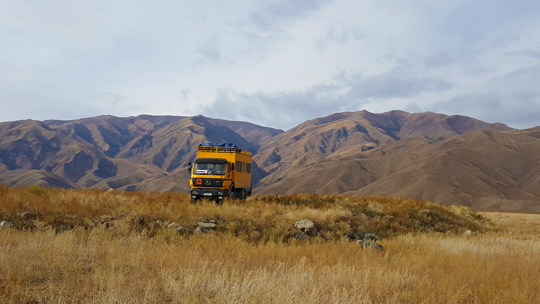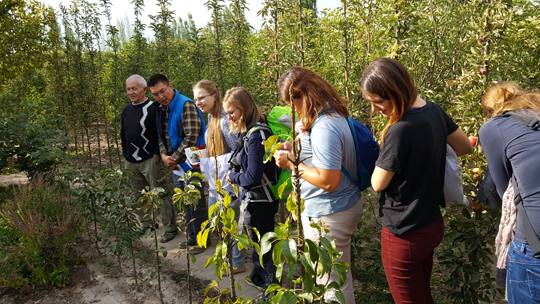High atop the yellow wagon through Kyrgyzstan
Freiburg, Feb 20, 2018
Mountains of freshly harvested cotton, reservoirs, flocks of sheep, cattle, goats, yaks and remnants of marauding markets from the Soviet Union: students from the University of Freiburg travelled through Kyrgyzstan for two weeks to explore how natural resource management in Central Asia works.

An old yellow truck took the group hundreds of kilometers through muddy high mountain slopes. Photo: Steffen Entenmann
Two weeks traveling through Kyrgyzstan: It sounds a lot like adventure and Karl May. But 14 students of Forest and Environmental Sciences brought along a ton of scientific questions during their excursion through the Central Asian country. That doesn’t mean adventure played no part in it: Bathing in mountains of freshly harvested cotton is unlikely to be part of the everyday experiences of any Central European student. Or travel hundreds of kilometers on muddy high mountain slopes in an old truck whose sunny yellow paint defies the monotone brown of the landscape.
Around five or six million people live in Kyrgyzstan (also known as the Kyrgyz Republic) which covers more than two-thirds of the German territory. A “totally unknown area” for the future forest scientist Alfred Heed from Eberswalde. “I have always dreamt of one day going to the former Soviet Union.” Kyrgyzstan, bordering the former Soviet republics of Kazakhstan, Uzbekistan and Tajikistan in the southeast on China, in the north, west and south, was a part of it at one time, a fact that did not play a minor role for the Freiburg group during its explorations.
Controversy over dammed water
“Natural Resource Management” is the name of elective module for the enrolled masters students. Before traveling to Kyrgyzstan, they listened to a series of lectures by external experts and developed the main themes, which they then worked on in small groups. The initial results - for example on the use of water in the mountainous region rich in reservoirs - were presented to Kyrgyz students on site: “The dissolution of the Soviet Union led to profound changes in resource management,” explains Dr. Steffen Entenmann, who accompanied the excursion together with four other colleagues from the Chair of Silviculture.
What used to be a cohesive system is now a controversial issue: The Kyrgyz people are damming the water and using it for power generation. But in the valleys of Uzbekistan it is urgently needed in the summer for the irrigation of cotton plantations. “There are conflicts about water amounts and times of use,” says Entenmann. In 2010, Osh, which is located on the border with Uzbekistan, attracted attention with its unrest between Kyrgyz and the Uzbek minority.

The students used local experts’ knowledge for their research. Photo: Steffen Entenmann
Also, the distribution of goods is no longer on schedule as in Soviet times: Kyrgyzstan as a meat supplier, Uzbekistan as a cotton supplier. Sheep, cattle, goats, yaks: tons of animals and their legacies have attracted the attention of travelers. What to do with them all? Traditionally speaking, the Kyrgyz people are pastoral people who view the possession of animals as a sign of prosperity. It wasn’t until the emergence of the Soviet Union that the nomads became settled, but during the warm summer months they would move with their herds to the somewhat distant summer pastures. It’s not worth doing that anymore: The markets have collapsed, the prices have fallen, the paths to the pastures are difficult and sometimes involve having to pass over country borders. The chairman of a local pasture committee explained this to the students. They noticed that an excavator was parked in front of the building. The animal owners want to help themselves by building pathways and bridges to reach the summer pastures more easily.
Thinking our way into another world
"The problem is the overgrazing of the remaining areas," says Entenmann, showing photos of ecologically valuable sea buckthorn and walnut forests. Everything has been nibbled to the bone, up to the treetops. According to Hesse, it is no longer about sustainable forest management. Not a single sapling has a chance to grow into a tree here. The view of the unkown sharpens the view of your own: In Germany, forest and pasture use are handled completely separately. A model for Kyrgyzstan? “The institutions that could implement are too weak or nonexistent,” the student summarizes. What is also lacking is the understanding that sustainable timber industry is worthwhile: “The people here are very poor and are primarily interested in survival.” At the moment, nature and landscape conservation are at a distinct disadvantage.
A lab internship could have never provided Alfred Hesse all the things he needs for his professional future that this excursion did: “I had to quickly think my way into another world. I learned that you have to consider a variety of interests and demands when thinking about the use of natural resources.”
Anita Rüffer

